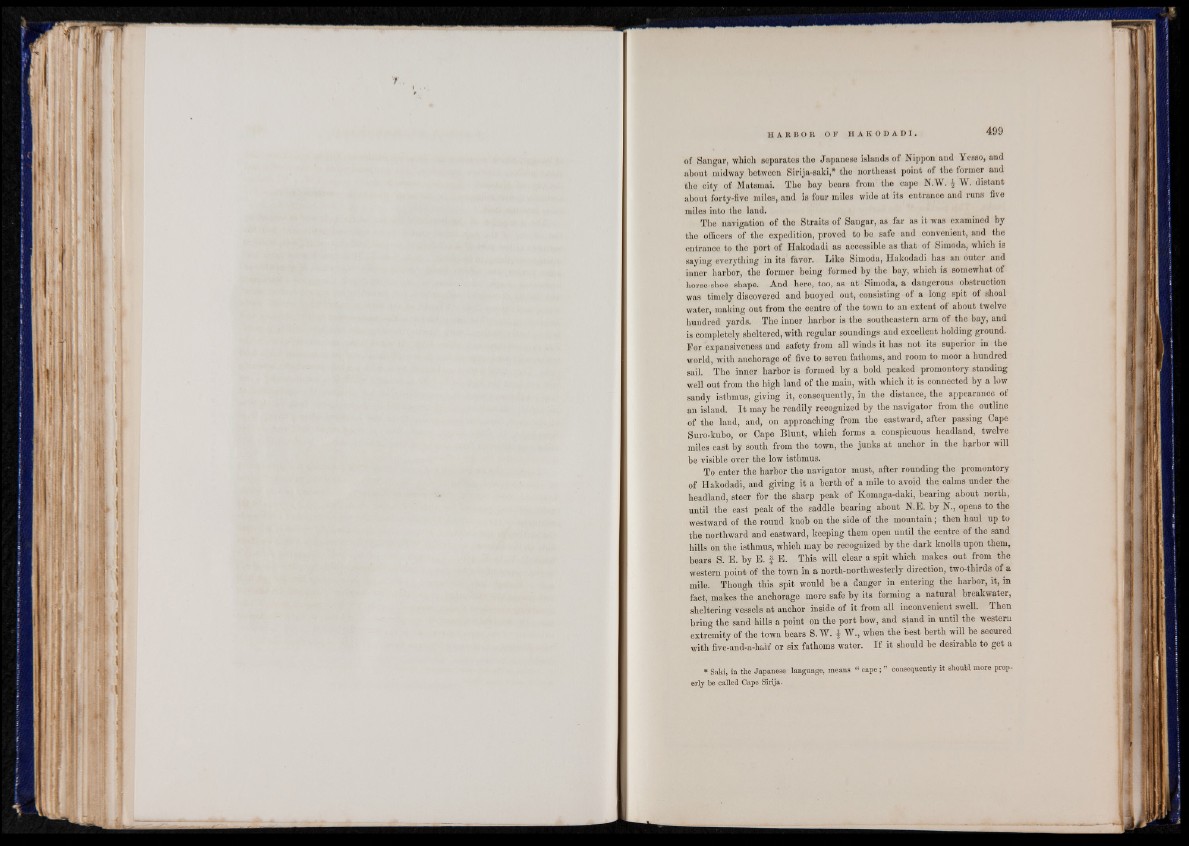
f l y ] ! H
I f
it
I I
I t
of Sangar, whioh separates the Japanese islands of Nippon and Yesso, and
about midway botween Sirija-saki,* the northeast point of the former and
the oity of Matsmai. The bay bears from the cape N.W. ^ W. distant
about forty-five miles, and is four miles wide at its entrance and runs fi' e
miles into the land.
The navigation of the Straits of Sangar, as far as it was examined by
the offioers of the expedition, proved to be safe and convenient, and the
entrance to the port of Hakodadi as accessible as that of Simoda, which is
saying everything in its favor. Like Simoda, Hakodadi has an outer and
inner harbor, the former being formed by the bay, which is somewhat of
horse-shoe shape. And here, too, as at Simoda, a dangerous obstruction
was timely discovered and buoyed out, consisting of a long spit of shoal
water, making out from the centre of the town to an extent of about twelve
hundred yards. The inner harbor is the southeastern arm of the bay, and
is oompletely sheltered, with regular soundings and excellent holding ground.
For expansiveness and safety from all winds it has not its superior in the
world, with anchorage of five to seven fathoms, and room to moor a hundred
sail. The inner harbor is formed by a bold peaked promontory standing
well out from the high land of the main, with which it is connected by a low
sandy isthmus, giving it, consequently, in the distance, the appearance of
an island. I t may be readily recognized by the navigator from the outline
of the land, and, on approaching from the eastward, after passing Cape
Suro-kubo, or Cape Blunt, which forms a conspicuous headland, twelve
miles east by south from the town, the junks at anchor in the harbor will
be visible over the low isthmus.
To enter the harbor the navigator must, after rounding the promontory
of Hakodadi, and giving it a berth of a mile to avoid the. calms under the
headland, steer for the sharp peak of Komaga-daki, bearing about north,
until the east peak of the saddle bearing about N.E. by N., opens to the
westward of the round knob on the side of the mountain; then haul up to
the northward and eastward, keeping them open until the centre of the sand
hills on the isthmus, which may be recognized by the dark knolls upon them,
bears S. E. by E. f E. This will clear a spit which makes out from the
western point of the town in a north-northwesterly direction, two-thirds of a
mile. Though this spit would be a danger in entering the harbor, it, in
fact, makes the anchorage more safe by its forming a natural breakwater,
sheltering, vessels at anchor ioside of it from all inconvenient swell. Then
bring the sand hills a point on the port bow, and stand in until the western
extremity of the town bears S. W. i W., when the best berth will be secured
with five-and-a-half or six fathoms water. I f it should be desirable to get a
* Said, in the Japanese language, means “ cape; ” consequently it should more prop-
erly be called Cape Sirija.